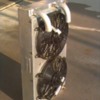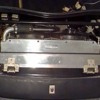quote:
My car runs cool on the freeway but the minutes I get into traffic it starts to heat up. I think it is either an airflow problem of a water flow problem.
So.... you would expect 80 MPH air flow to be equaled by a couple of fans?
Of course the temp will go up in city traffic.
Do you then have boiling, overflow problems? Then you do have a situation needing attention.
But just a temp increase with no other issues is normal. On a PCNC outing last weekend, 2511 hit 210 degrees on the mechanical VDO gauge while entering Golden Gate Park in very slow traffic. But that is still quite a bit from boiling in a 16 pound pressurized system, and other than the high temp, there were no other issues.
I just hate to see you chasing a problem that may not need chasing. Have you calibrated your temp gauge so the shown temp IS the actual temp? You can do this with a candy thermometer in the surge tank - compare that reading to your console gauge reading.
Bottom line - no boiling over, no real problem.
My 2¢
Larry



